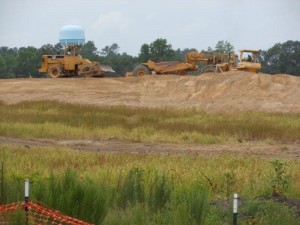
Road construction continues on I-73 through Richmond County as an interchange develops south of Ellerbe on U.S. 220 where I-73 will branch off toward the Pee Dee River to connect with the U.S. 74 Bypass of Rockingham.
I-73 continues through Richmond County
Highways dont just drop out of the sky, G. R. Kindley Jr. of Rockingham, once said.
He would know after 16 years and four months serving as the Division 8 Representative on the North Carolina Board of Transportation, N.C. Department of Transportation.
Once called Mr. I-73 for his aggressive promotion of the new Interstate I-73 through North Carolina, Kindley shepherded the project as it made its way from county to county across the Central Piedmont of the state from Virginia to South Carolina.
From the time it was conceived in 1978 to 2014 has been 36 years so far and many more years to go. It has not, as Kindley said, just dropped out of the sky.
Kindley was first appointed a member of the Transportation Board in 1993. Once I was inside as a member, I found out it was a longer period of time to do road projects than I thought.
Richmond County in 2014 was the scene of a massive I-73/74 highway interchange area under construction on the present U.S. 220 highway south of Ellerbe prior to any interchange being constructed.
It will eventually connect the present I-73/74 bypass of Ellerbe to U.S. 74 west of Rockingham, known as the G. R. Kindley Freeway. From the Freeway south of Hamlet, I-73 will enter South Carolina near N.C. 38.
I-74 joins I-73 south of Randleman to form I-73/74. It will one day continue east on the present U.S. 74 route.
The connection in Richmond County to U.S. 74 still awaits funding for final completion. The South Carolina I-73 connection to the Grand Strand area on the coast is still under discussion.
The cost of the connection south of Ellerbe to U.S. 74 in 2014 was estimated at about $212 million, which is not funded. When it will be completed depends on the availability of federal and state funding and priorities. Present funding stops at the current work on U.S. 220 which involves access roads being constructed for the interchange area.
The total cost of I-73/74 through North Carolina was once estimated at $2.2 billion.
In 2014, North Carolina was the only state on the route from Michigan to South Carolina that had finished sections of I-73.
It wasn’t until 1991 that Kindley joined the effort for I-73. The effort began as a local widening of U.S. 52 in Greater Bluefield, West Virginia. James Armstrong, Rockingham City Planner, was also involved.
Kindley was selected to be chairman of the effort by a group known as the National 1/73/74 Corridor Association, and Armstrong was the secretary. In 1995 it became the 1-73/74 Association – North Carolina in which Kindley and Armstrong were involved. In 2007, the national association was re-formed to lobby Congress. By this time I-73/74 was already in the NCDOT system.
During the development of the project, there were a series of meetings of all states involved known as road rallies. To influence federal funds for the project, Kindley went to Washington, D.C., four times. He once spoke to the U.S. House Subcommittee on Surface Transportation of the Committee on Public Works and Transportation, 103rd Congress.
In 1994, the U.S. Senate passed the Highway Bill with I-73/74 included. In 1995, the U.S. Senate Environmental and Public Works Subcommittee approved North Carolina’s plan for I-73.
North Carolina has done well with construction because there was a lot of unity and support in the state for the project. And, it had an almost ready-made long and adaptable four-lane highway with U.S. 220.
Other states have each encountered differences of political and public opinion concerning routes, environmental impacts and costs of construction.
Once Kindley was on the state board, he was able to persuade the route through North Carolina follow the path of U.S. 220 rather than U.S. 52 as some proposed.
During the time Kindley was involved in the I-73/74 project, he always had the support of North Carolina Governors who kept re-appointing him to the Transportation Board.
When his efforts were fulfilled, Kindley resigned from his volunteer position on the Transportation Board in 2009.
The last section of I-73/74 in Richmond County will be known as the Western Rockingham Bypass from the U.S. 74 Kindley Freeway Bypass/U.S. 74 Business Rockingham to the I-73 Interchange and U.S. 220 Alternate now under partial construction in 2014 south of Ellerbe. All work is done in phases. As mentioned, there are no funds to go further at the present.
In the latter part of 2012, I-73/74 from Ellerbe to Greensboro had become Interstate, not Future. Kindley said. There were no stoplights between Greene Street in Rockingham to the city of Greensboro on the route.
Also that year, the state constructed two Rest Areas on the route near Seagrove in Randolph County.
I-73 will be North Carolina’s second longest Interstate highway, totaling about 300 miles, trailing only I-40’s 420 miles, but ahead of I-85’s 233 miles.
Kindley said the benefits for Richmond County are that more people would be coming this way and open opportunities for more development. For the state, it is all about moving traffic from one destination to another. It is something for the future to build upon, he said.
Tom MacCallum
